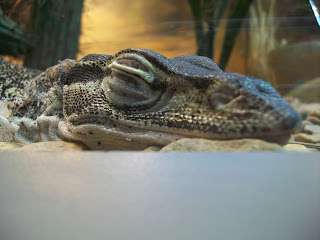Last semester I had an internship at the South Carolina Aquarium working in the Sea Turtle Hospital. If you are an SC resident, I would enthusiastically give two thumbs up for interning over there. While I was there, we were caring for 11 sea turtles suffering from a variety of maladies and one box turtle who had a chipped plastron. Most of the turtles had been hit by boats. As can be seen in this picture of North Myrtle, a juvenile loggerhead. He (or she) came in about midway through my internship and no one believed he would survive. His carapace had seven fractures running through it and was completely unstable. Any time N. Myrtle would move bits of its shell would shift in different directions. Furthermore, he came in with pneumonia. So for about 3 hours a day we would sit a nebulize him (give him medicine through inhalation) which is very tedious as turtles don't breathe but once every 5-20 minutes.

As you can see in the after picture, karatin is beginning to move into the wounds and make his shell much more stable. However, it is still doubtful if North Myrtle will be able to be released into the wild.
While most of the injuries the hospital sees are boating related, they also receive turtles who too close to shark teeth as well as turtles that have been almost drowned or are cold-shocked by becoming trapped in fishing nets. Most of the turtle injuries are due to human interactions.
Of sea turtle strandings (turtles found deserted along the beach), only about 10% are still alive. Many of the dead turtles are brought into the aquarium and, along with DNR, necropsies (animal autopsies) are performed to find the cause of death. Often there are differing means for the turtles' deaths but one common factor in most of the animals is the accumulation of garbage found within the turtles stomachs or intestines. Plastic bags, styrofoam, etc are all ingested by the turtles.
Myrtle, a young Kemp's Ridley sea turtle, also found his way into the hospital after being struck by a motor boat. His wounds were likewise very traumatic and survival looked slim. His wound was on his head and cut his face almost in half. They wired it shut, as you can see. This little guy is having much more trouble than North Myrtle. He is most likely blind in his left eye, can't dive lower than a foot (he is stuck floating at the surface), and has trouble eating. Still the fact he survived is pretty impressive.

Moral of the story: don't litter and be careful with your motor boats.
Sara Smith
College of Charleston




















